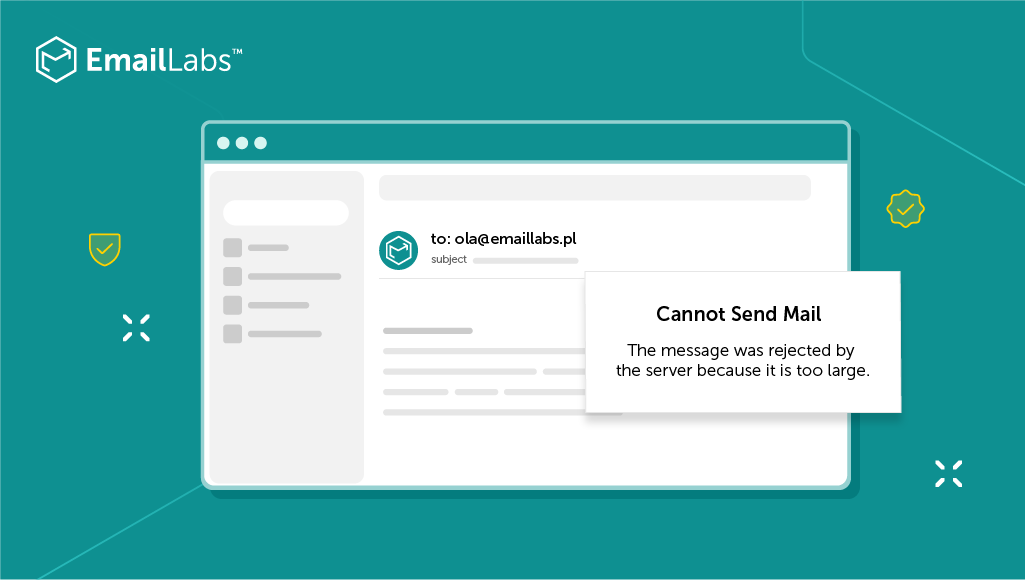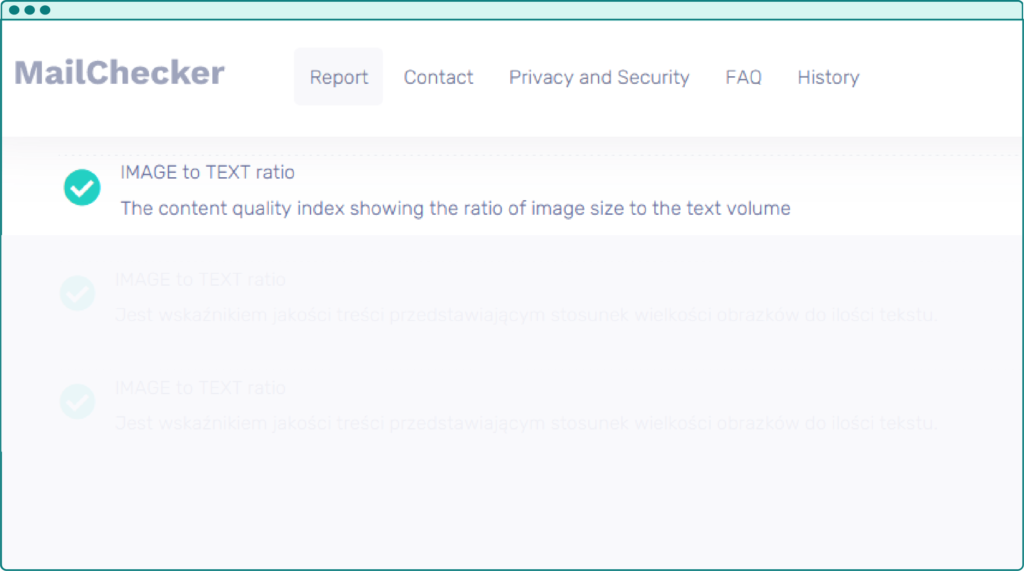Best practices, Deliverability
Best practices, Deliverability

Are you planning an extremely interesting promotional campaign and a newsletter with lots of great offers? When preparing your email, remember that more is not always better. By sending out large messages, you will not only make the campaign run at a slower pace – you can lead to messages not reaching your recipients at all. There’s nothing worse than a missed conversion opportunity due to an improperly crafted mailing. Check out what you can do to optimize the size of emails and increase the chances of your emails being delivered correctly.
Every email message has its size (also called weight), which affects the way servers and the mailbox itself will handle its content. The weight depends both on the HTML code (tables, text, links) and graphics embedded in the email or files added as attachments. The larger the email message, the more likely it is to encounter problems during its delivery – very large emails may take longer to send, and queuing on the server-side may cause problems for the whole sending infrastructure. Providers may also limit the acceptance of such emails due to technical limitations on their side – some systems (e.g. EmailLabs) will retry sending such deferred emails), and others simply will not deliver them.
The maximum size of a message sent via EmailLabs is 15 MB.
Learn more about this limit on our platform in this article.
Unlike the size of graphics, the size of the HTML code has a direct impact on deliverability – spam filters may consider a message over 100KB as potentially dangerous.
To provide the best possible experience to the recipient, it is very common to include additional elements in email. Remove unnecessary ones – e.g. unused styles, comments, or blank spaces – this process is called minification. You can find many free online tools that will do it for you.
Remember that in Gmail, once you exceed the 102 KB limit, the email message is clipped – you won’t see the full content until you click “[Message clipped] Show entire message “. Learn more about message clipping in Gmail in this article.
While checking the weight of the prepared code, don’t forget the tracking that will be added to the message during sending. By using this functionality, a tracking element is added to each link, which allows us to monitor the recipient’s activity – e.g. link-clicks time for statistics purposes.
Apart from the size of the HTML code itself, graphics placed in the e-mail design are an important issue. We are talking here not only about product photos, but also about backgrounds, logotypes, and all those elements which make our message visually attractive for the recipient.
While graphics usually do not have a direct impact on the deliverability to recipients’ mailboxes, they are important when we talk about the speed of sending messages and the time of their loading (rendering) directly in the mailbox. Although technological progress means that we have better and better access to high-speed Internet connections, it does not change the fact that a ‘heavy’ message may take a very long time to load in the mailbox – especially on mobile devices (which may result, in example, from a temporary loss of network coverage). If the message takes too long to load, the recipient may delete it before reading its content.
Remember that the ratio of graphics to text is one of the significant elements that anti-spam filters evaluate. According to good practice, the ratio of text to images should be 60:40. Preparing emails solely based on images is the domain of spammers who try to bypass the “reading of the content” by the aforementioned filters, which is why such a message may seem suspicious and consequently be blocked or redirected to the SPAM folder.
You can check the evaluation of your e-mail and the ratio of text to images e.g. using a free tool MailChecker.net:

reduce the size of emails
Adjust the size of the prepared email – the optimal width is 600 px. As for the length – it’s good for the template to be between 1500 and 3000 px – don’t make your recipients scroll endlessly! Email marketing best practices have always highlighted the benefits of getting subscribers from the inbox to the landing page as quickly as possible – that’s where you should place all the details.
The most popular graphic formats used in e-mails are jpg and png. The second one is heavier than jpg but supports transparency – important if the prepared mailing must be displayed correctly in dark mode.
If the images you receive from a graphic designer are high quality, use a program for scaling them. You can find many free editors on the Internet.
This is what a sample HTML code snippet containing an image and alternative text looks like:
<img src=”image path” alt=”alternative text”>
Many email programs and spam filters block emails containing attachments because they are perceived as potentially dangerous. Files that appear to be ordinary, may contain malicious software designed to steal data (phishing) and therefore may seem suspicious.
When planning an extensive campaign for your recipients, upload selected files to your server and include a link in the body of the e-mail that will allow the recipient to download them. Thanks to this solution, the message has a smaller size, which not only has a positive effect on the speed of its sending but also increases the chance that the message will not be stopped or directed to the SPAM folder.
Here is an example HTML code snippet containing linked content:
<a href=”file path”> text</a>
Additionally – when using link tracking, you will be able to check which recipients click on the link to download the file, which you cannot measure by placing it as an attachment.
Before the prepared e-mail goes to your subscribers’ inboxes, test it thoroughly – preferably by sending test messages to the mailboxes of various ISPs (seed lists) and the most popular e-mail programs (both desktop and mobile). This will allow you to check not only whether the message itself reaches the mailbox (whether it has not been stopped by the receiving server), but also whether it has not been clipped (Gmail), and whether alternative texts are displayed correctly in place of graphics (Outlook).
At EmailLabs, we do everything to ensure the best possible deliverability of your messages. Great servers and adequate security are not enough! The maximum size limit of the messages that ESP supports may differ from the one that applies to the recipients of your e-mails. Therefore, it is worth preparing them to follow good practices, which say that the optimal size of an email is about 10 MB. So good deliverability also depends on you.
Do you have any questions? Contact our Support Team ([email protected]).
We live in a world where your customers switch seamlessly between laptops, smartphones, and tablets. They navigate a complex digital ecosystem – checking emails, using mobile apps, and reacting...
We are delighted to announce that Vercom S.A., the company behind the EmailLabs project, has successfully completed the ISO 22301 certification process. This significant achievement underscores our commitment to...
EmailLabs, as part of the Vercom group, proudly announces its full commitment to aligning its ICT services with the latest cybersecurity standards. In response to dynamically changing regulations, the...
We are pleased to announce that MessageFlow, a product from the Vercom S.A. group, has received the prestigious CSA (Certified Senders Alliance) Certification. This recognition not only underscores the...
Gmail, Google and Yahoo's Requirements
You might have noticed a new item in your Gmail sidebar recently – the “Manage subscriptions” tab, often flagged with a blue notification dot. While Google announced this feature...
IT & Tech, Pytania i odpowiedzi, Technical
Efficient email communication isn’t just about sending messages — it also involves integrating email functionality into your business systems and applications. Email APIs (Application Programming Interfaces) serve as the...
One of the most important yet often underestimated elements in shaping a company’s brand perception is the transactional email. In e-commerce, the design of such messages must be carefully...
Gmail, Google and Yahoo's Requirements
You might have noticed a new item in your Gmail sidebar recently – the “Manage subscriptions” tab, often flagged with a blue notification dot. While Google announced this feature...
IT & Tech, Pytania i odpowiedzi, Technical
Efficient email communication isn’t just about sending messages — it also involves integrating email functionality into your business systems and applications. Email APIs (Application Programming Interfaces) serve as the...
One of the most important yet often underestimated elements in shaping a company’s brand perception is the transactional email. In e-commerce, the design of such messages must be carefully...
Google and Yahoo's Requirements, Yahoogle
2024 brought fundamental changes to email marketing, introducing new, stringent requirements for senders. Since February 1, 2024, Google and Yahoo have started enforcing new deliverability rules, primarily targeting bulk...
We live in a world where your customers switch seamlessly between laptops, smartphones, and tablets. They navigate a complex digital ecosystem – checking emails, using mobile apps, and reacting...
Are your campaigns not engaging all recipients as you expect? Do they fail to open your emails or click on links, lowering your campaign effectiveness and email marketing ROI?...
Gmail, Google and Yahoo's Requirements, Updates
Gmail’s educational phase has ended. Google has officially announced the start of a new phase – the Gmail Enforcement Phase – which begins to take effect in November 2025....
Running a business requires professional communication channels. While free personal email services might work for individual use, they fall short when representing a business. Understanding the fundamentals of email...
Email routing requires sophisticated mechanisms to ensure messages reach their intended recipients across the vast landscape of the internet. At the heart of this email delivery system lies the Mail...